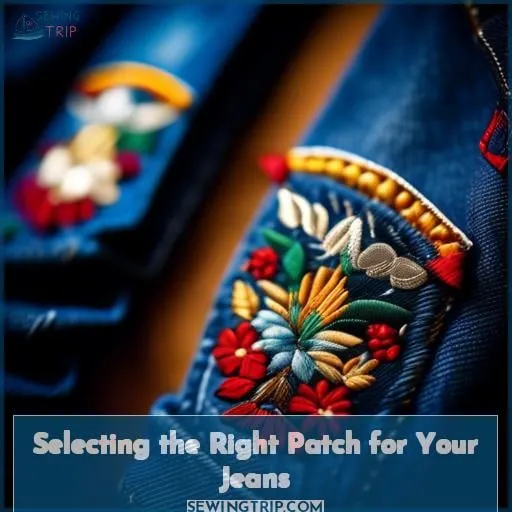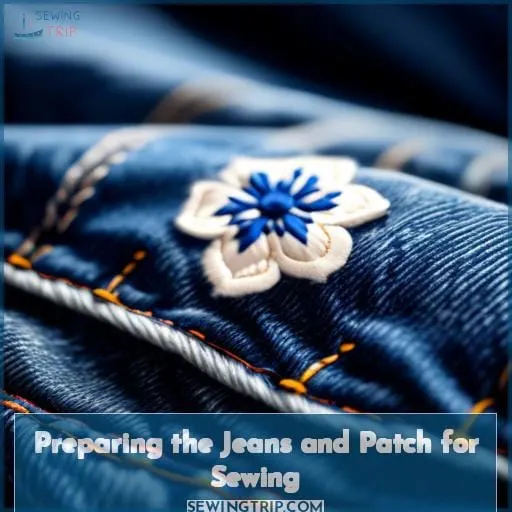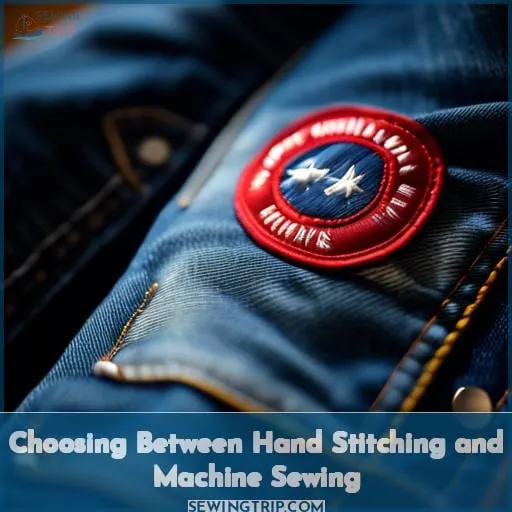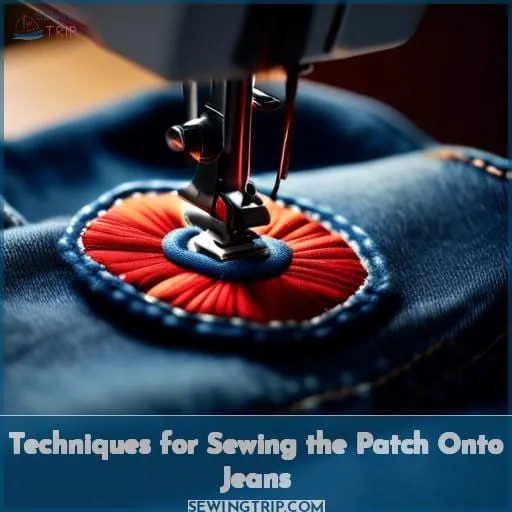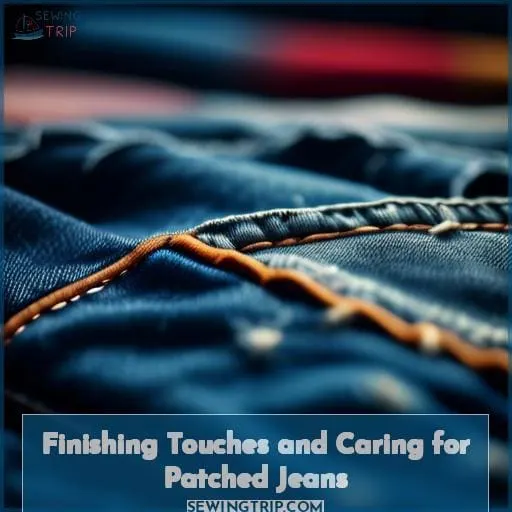This site is supported by our readers. We may earn a commission, at no cost to you, if you purchase through links.
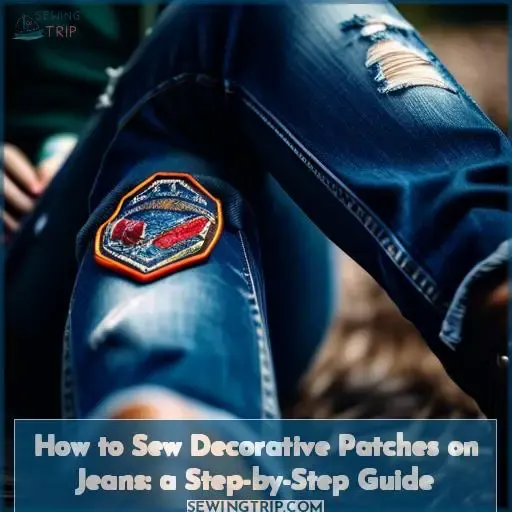 Transform your denim from drab to fab with the art of sewing decorative patches on jeans.
Transform your denim from drab to fab with the art of sewing decorative patches on jeans.
This timeless technique marries the old with the new, breathing life into your wardrobe while showcasing your unique style.
Whether you’re aiming for a touch of whimsy or a bold statement, the right patch can elevate your jeans to a work of wearable art.
You’ll need patience and a keen eye for detail, but the freedom to innovate your own fashion is well worth the effort.
Get ready to master the craft of sewing on patches and express your individuality with every stitch.
Yes, sewing decorative patches on jeans is a straightforward process. To sew decorative patches on jeans, first select a patch and position it on the jeans, then secure it with pins or temporary adhesive before sewing around the edges with a heavy-duty needle, either by hand or using a sewing machine.
Table Of Contents
Key Takeaways
Ensure the patch material is compatible with denim and can withstand embroidery and durability testing, while also coordinating the colors to either match or contrast with the jeans.
Properly prepare by ironing out wrinkles from both the jeans and patch, selecting thread that complements the materials, and choosing the right needle size for the thickness of the denim and patch.
Choose between hand stitching for more control and precision or machine sewing for greater speed and efficiency, and adjust the sewing machine settings to accommodate the fabric thickness.
After sewing, iron the patch for a neat finish, and maintain the jeans by washing them gently, repairing any torn patches, and storing them in a cool, dry place to ensure longevity.
Selecting the Right Patch for Your Jeans
When you’re ready to personalize your jeans with decorative patches, it’s essential to consider the patch material’s compatibility with denim.
Aim for a harmonious look by coordinating the colors of your patches with your jeans, ensuring they complement each other.
Additionally, the size and shape of the patches, along with their design and texture, should align with your creative vision and the jeans’ style.
Patch Material Compatibility
When selecting the right patch for your jeans, consider these key factors:
- Patch Material Compatibility: Ensure the patch material is compatible with your jeans for both durability and adhesive bonding. You’ll want a patch that can withstand the same wear and tear as your denim.
- Embroidery Compatibility: If you’re planning on adding embroidered designs, check that the patch fabric supports the intricacy of embroidery without fraying.
- Durability Testing: Perform a durability test, like the Wyzenbeek method, to ensure the patch can endure repeated use and movement without peeling or tearing.
Color Coordination
After ensuring your patch material is compatible with your jeans, it’s time to consider color coordination. The hues you select can either make your patch stand out or blend seamlessly. Pay attention to hue selection and saturation consideration to achieve the desired contrast effects.
| Patch Placement | Color Matching | Contrast Effects |
|---|---|---|
| Pockets | Complementary | Bold |
| Knees | Analogous | Subtle |
| Thighs/Hips | Monochromatic | Streamlined |
Choose patch placement wisely; pockets offer prominence, while knees can suggest a casual vibe. For a harmonious look, ensure color matching aligns with your jeans’ palette. Finally, consider the contrast effects: a complementary color creates a bold statement, analogous hues offer subtlety, and a monochromatic approach maintains a streamlined aesthetic.
Size and Shape Considerations
After considering color coordination, it’s crucial to think about the size and shape of the patch you’re choosing for your jeans. These elements significantly influence the final look, impacting both aesthetics and the message you wish to convey.
- Placement position determines how the patch integrates with the jeans’ overall design, affecting visibility and interaction with other elements.
- Patch size impact can either highlight or subtly blend the patch with your jeans, depending on the statement you’re aiming for.
- Shape influence plays a key role in the patch’s harmony with the jeans’ lines and curves, enhancing the garment’s visual appeal.
- Aesthetic implications of visible or hidden stitch choices can add to the patch’s charm, offering either a seamless look or a deliberately crafted, hand-finished appearance.
These considerations ensure your patched jeans not only reflect your personal style but also stand out as a unique piece of wearable art.
Design and Texture
After considering size and shape, dive into the creative aspects of design and texture for your patch.
Think about how the patch’s design can complement or contrast with your jeans. Are you aiming for a bold statement or a subtle addition?
Embellishment ideas like contrast stitching or layering techniques can add depth and interest.
Preparing the Jeans and Patch for Sewing
After selecting the perfect patch for your jeans, it’s time to prepare both the jeans and the patch for sewing. This step is crucial for ensuring a smooth sewing process and a durable finish. Begin by deciding on the patch placement.
It’s important to visualize how the patch will look once the jeans are worn, so consider laying the jeans flat and experimenting with different positions. Once you’ve found the ideal spot, it’s time for fabric prep. Iron both the jeans and the patch to remove any wrinkles, ensuring a flat surface for sewing.
This ironing technique not only smooths out the fabric but also helps in aligning the patch accurately.
Thread selection is next. Choose a thread that either matches the color of your patch or your jeans, depending on whether you want the stitching to stand out or blend in. The type of thread you use can add to the durability and aesthetic of the patchwork.
Needle size is also important; a thicker needle may be necessary for denim, especially if the patch material is also thick. A larger needle can handle the fabric’s weight without breaking, making your sewing experience smoother.
By carefully preparing your jeans and patch, you’re setting the stage for a successful sewing project. This preparation phase isn’t just about the technical aspects but also about infusing your creativity and personal touch into the jeans, transforming them into a unique piece that reflects your style.
Choosing Between Hand Stitching and Machine Sewing
When deciding how to attach decorative patches to your jeans, consider the precision of hand stitching versus the speed of machine sewing.
Selecting the right needle type is crucial for the fabric and patch you’re working with, and ease of fabric manipulation should also guide your choice.
Whether you opt for the meticulous control of hand sewing or the efficiency of a sewing machine, your approach will impact the final look and durability of your patched jeans.
Hand Stitching Precision
After preparing your jeans and patch, it’s time to dive into the art of hand stitching. This method offers unparalleled precision, allowing you to control every stitch with patience and creativity.
Opt for a backstitch for its durability, ensuring your patch remains secure through wear and tear. Pay close attention to thread tension consistency to avoid fabric puckering, which can mar the beauty of your project.
Stitch length optimization is key; too long, and your patch may fray or detach, too short, and you risk bunching the fabric. Remember, avoiding fabric puckering and fraying prevention are as crucial as the stitch itself.
Embrace this process with attention to detail, and you’ll not only repair but also reinvent your jeans with a personal touch.
Machine Sewing Speed
When opting for machine sewing to attach decorative patches to your jeans, you’ll marvel at the speed it offers.
You’ll need to adjust your machine settings to accommodate the fabric thickness and patch material. Selecting the right needle size is crucial; a size 90/14 or 100/16 needle is robust enough for thicker fabrics or multiple layers.
Pay attention to seam allowances, ensuring they’re consistent for a neat finish. Adjust stitch length and tension to prevent puckering and achieve smooth seams.
With machine sewing, you’re not just saving time; you’re also opening up a world of precision and creativity in your sewing projects.
Needle Type Importance
While machine sewing offers speed, choosing the right needle is crucial for the success of your project. Needle size, sharpness, durability, and point shape significantly affect your sewing experience and the final look of your jeans.
A 90/14 needle is ideal for light to medium-weight denim, while a 100/16 better suits heavyweight fabrics. Ensure the needle’s thread compatibility to avoid breakage and ensure smooth sewing.
This attention to detail ensures your decorative patches are attached with precision, enhancing both the durability and aesthetic of your jeans.
Fabric Manipulation Ease
After considering the importance of needle type, let’s delve into the ease of fabric manipulation, a crucial aspect when choosing between hand stitching and machine sewing.
Ironing techniques can significantly simplify the process, ensuring your patch aligns perfectly with the jeans. Paying attention to seam allowance ensures the durability of your work, while thread selection can impact both the aesthetic and strength of the patch.
Pattern matching and embellishment options offer creative freedom, allowing you to transform a simple repair into a unique fashion statement. With patience and creativity, you’ll master these techniques, turning each patch into a testament to your innovative spirit and attention to detail.
Techniques for Sewing the Patch Onto Jeans
When sewing a patch onto your jeans, you’ll want to ensure the final result is both durable and stylish.
- Edge Stitching: Begin by securing the patch with edge stitching, which is a straight stitch very close to the edge of the patch. This not only attaches the patch but also gives a neat finish.
- Decorative Stitching: If you’re feeling creative, use decorative stitching to add a personal touch. A blanket stitch can be particularly effective for a hand-sewn, artisanal look.
- Zig Zag Stitch: For a strong hold and a decorative flair, a zig zag stitch is ideal. It’s especially useful for preventing fraying on the edges of your patch.
Finishing Touches and Caring for Patched Jeans
After meticulously attaching your patch, it’s time to ensure it stays in place and looks great for as long as possible. Ironing the patch can help secure it further and give a neat finish. Be mindful when washing and drying your patched jeans; treat them gently to maintain their integrity.
If you encounter torn patches, a few careful stitches can salvage your handiwork. Should you decide to remove old patches, do so with patience to avoid damaging the fabric.
Here’s a handy table to help you remember the key points for maintaining your patched jeans:
| Care Aspect | Tips | Don’ts |
|---|---|---|
| Ironing the Patch | Use appropriate heat settings | Iron directly on the patch without a cloth |
| Washing and Drying | Hand wash or use a gentle cycle | Over-wash or use harsh detergents |
| Repairing Torn Patches | Sew with matching thread | Ignore loose threads |
| Removing Old Patches | Use adhesive remover if necessary | Pull off patches forcefully |
| Storing Patched Jeans | Fold and store in a cool, dry place | Hang, which may stretch the fabric |
Frequently Asked Questions (FAQs)
How can I repair a patch that’s starting to peel off from my jeans?
To fix a peeling patch, gently remove it. Apply fabric glue on the back. Carefully reposition it on your jeans and press firmly.
Are there any specific types of fabric that should not be used for patches on jeans due to durability or washing concerns?
Avoid delicate fabrics like silk or wool for patches on jeans; they may not endure the rough-and-tumble of daily wear and frequent washing.
Stick to sturdy materials like denim or canvas that can take a beating.
Can decorative patches be applied to areas of jeans that are not flat, such as over seams or pockets, without affecting the functionality of the jeans?
You can indeed apply patches over seams or pockets on jeans, ensuring they don’t hinder the pocket’s use or seam’s function.
Carefully sew without closing the pocket or altering the seam’s flexibility.
How can I ensure that the color of the patch does not bleed into the jeans during washing?
To prevent your patch’s vibrant hues from wandering during washes, embrace a pre-wash ritual.
Submerge your jeans in a cold bath sprinkled with a cup of white vinegar, letting them soak for about an hour.
This simple spell binds the colors, ensuring they stay put, allowing you to strut in your customized jeans without fear of a color parade.
What are the best practices for storing jeans with decorative patches to maintain their appearance and prevent damage?
To store jeans with decorative patches, fold them neatly to prevent creases.
Avoid hanging to maintain patch integrity.
Store in a cool, dry place away from direct sunlight to prevent fading.
Consider using fabric bags for added protection.
Conclusion
Embarking on the journey of sewing decorative patches on jeans, you’ve now unlocked a realm where your creativity knows no bounds.
With patience and a keen eye for detail, you’ve learned to blend tradition with personal flair, transforming ordinary denim into a canvas of self-expression.
Whether you choose the precision of hand stitching or the efficiency of a machine, remember, each stitch is a reflection of your unique style.
Care for your patched jeans, and they’ll tell your story for years to come.

